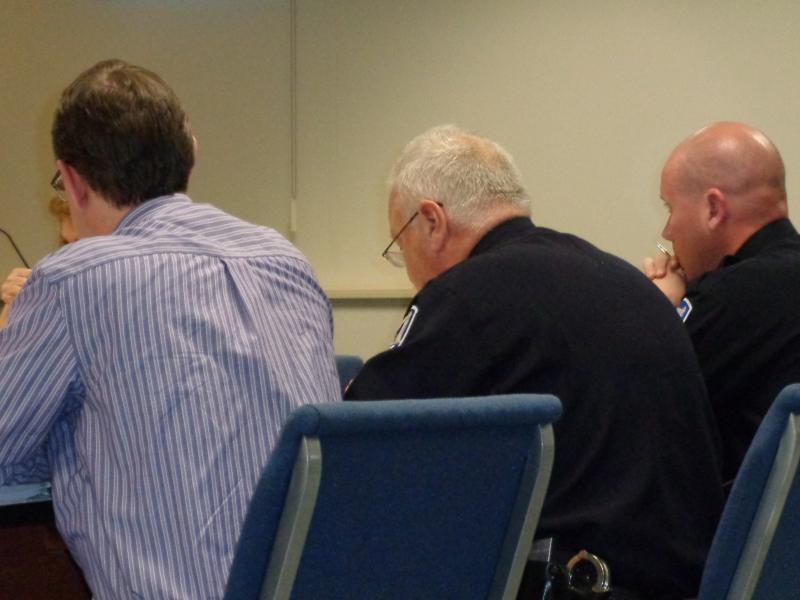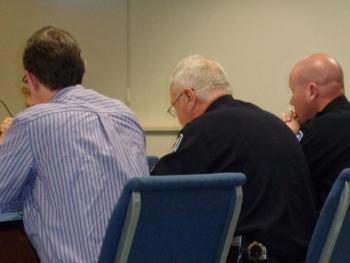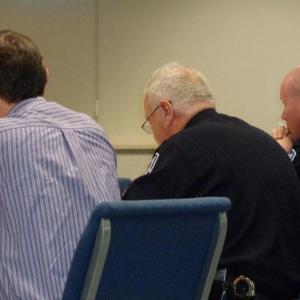Rockland crime rate decreases since 2007
ROCKLAND — In preparation for the Monday, May 4, budget meeting with the Rockland City Council, Police Chief Bruce Boucher and City Manager James Chaousis pulled together some statistics affecting the police department and its proposed fiscal year 2016 budget of $1,604,092. Shown in the statistics is a decrease in the crime rate between 2007 and 2013.
The City of Rockland had a 2007 crime rate average of 55.26 percent based on its resident population of 7,385, plus its transient population, which totals a daily average of 11,000 people. In 2008, the crime rate increased to 62.7 percent before beginning steady decline into 2013, when it had an average crime rate of 34.56 percent.
Councilor Valli Geiger asked how many of those service calls have dropped since Walmart moved to Thomaston.
Boucher said: “If you start looking at those numbers and comparing: In 2008, Rockland had the fourth highest crime rate in the state, behind Augusta, Bangor and Calais, respectively. In 2009, it was number nine. In 2012, it was number 12. In 2013, that dropped to 23. In preliminary data that I’ve received, it has dropped again in 2014. Walmart did make an impact. Shoplifting, larceny of services is a big generator.”
“And the time spent to go to court to testify about it,” said Geiger.
Though Boucher agreed that the relocation of Walmart to Thomaston affected the drop in Rockland’s crime rate, he was reluctant to agree to how big of an impact the relocation had.
According to the Chief, 80 percent of crimes are committed by 20 percent of the population.
“The way Maine bases the UCR statistics, it’s not 100,000 population, it’s like 1,000 population,” he said. “We could have one individual who goes on a burglary spree who can completely skew those statistics.”
According to the Maine Office of Public Safety, during the 1920s the members of the International Association of Chiefs of Police formed the Committee on Uniform Crime Reporting with the intent to develop a standardized system of police statistics.
The crime rate involves the number of Index Crimes per unit of population, usually per 100,000 persons. Because Maine has such a low population total, a rate per 1,000 persons has been used to reflect a more realistic volume, the Public Safety Office said, in its 2012 report.
According to the data, Rockland has a daily average transient population of 11,000. However, this number does not take into consideration winter lulls and summer highs. The chief estimates the summer population to be three times that amount.
The data collected for this council meeting also had similar statistics for Bath, Ellsworth, and Belfast. These three municipalities are coastal county seats, are service centers, and have comparable population sizes. However, as Chaousis stressed to the council, each municipality has its differences and individual issues.
“We put this information together, and I’m not sure it tells you anything,” he said. “We want to be able to say, OK, it’s fair to analyze the police department to other police departments of similar size, but even if you’re looking at expense, even if you’re looking at crime data, if you’re looking at transient population — a lot of different variables — I’m not sure it tells the whole story.”
Rockland’s per capita income in 2012 was $21,396. The poverty level, based on a year 2000 census was 14.7 percent, compared to Ellsworth, which had a per capita of $27,383 and a poverty level of 9.2 percent.
“I’m not trying to punish success,” said Geiger. “You’ve done an extraordinary job here, and part of it may be that Walmart moved out. But, it’s also that the town is changing a little bit. If you look at our poverty rate [14.7 percent based on a year 2000 statistic] compared to, say Bath, it is much lower than Bath. But it is higher than either of the other two, which makes a huge difference in terms of the types crime and the amount of crime.”
Geiger suggested that if, in the future, the crime rate stays at the same rate as the other three cities, then perhaps not filling every vacant police position should be considered.
The crime rates for the other cities, in 2013 were:
Bath, 36.14 percent for a population of 8,357;
Ellsworth, 35.53 percent for a population of 7,015; and,
Belfast, 24.5 percent for a population of 6,653.
According to Boucher, two officers have retired, both with salaries at the top of the pay scale. New officers, if the positions are filled, would not be paid as much. Boucher has one potential new officer in mind to hire, but has not done so yet.
“We see every day the impact of what’s going on here,” he said. “I think over the past eight years we have done everything we can to keep those costs down.”
The police budget, according to chief, has gone up $155,000 over the past eight budget cycles. That’s a one percent increase each year.
“In that same time, we have taken in ancillary grants in federal, state, and private grants that have funded numerous CIP requests,” he said.
Councilor Will Clayton asked Boucher if he had any dire budgetary needs. Boucher spoke of previous grant funding for their vehicles. That funding has run out, and the vehicles, along with the special equipment inside, are aging and harder to fix.
The council adjourned without taking any action.
Event Date
Address
United States

























